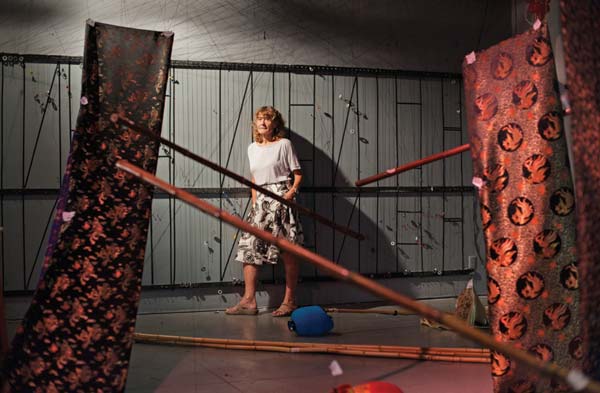Puppeteer spins two Chinese yarns with new vigor
Updated: 2012-09-19 10:59
By Kelly Chung Dawson in New York (China Daily)
|
||||||||
|
 Hanne Tierney on the set of Strange Tales of Liaozhai. Her production presents two supernatural stories from the Qing Dynasty (1644-1911). Hiroki Kobayashi / for China Daily |
Two supernatural tales from the Qing Dynasty (1644-1911) have been brought to life this month by the renowned puppeteer Hanne Tierney and projection artist Hannah Wasileski.
With abstract brush stroke animation and a fabric landscape controlled by an elaborate 100-string counterweight system, the embroidered brocades, silks and bamboo poles become characters themselves in an homage to the playwright Gertrude Stein, who experimented with theater as landscape in the 1920s.
Drawing from Pu Songling's 1740 collection Strange Tales of Liaozhai (also known as Strange Stories from a Chinese Studio), Tierney's production presents two stories: a sad tale of magical pigeons and a story about the struggles of love between a fox spirit and her mortal husband.
Both are scored by composer and musician Jane Wang, who provides accompaniment on toy pianos and double bass. Tierney controls the counterweight system in clear view of the audience, narrating the production into a headset microphone. The result is an eerie blend of both modern and ancient aesthetics.
"I hope that Western audiences will come away with a sense of the beauty of that time," Tierney said.
"I wanted to show the clean simplicity with which Chinese people approached their clothing at the time and the use of fabric panels accentuated that. To me, there is a beauty in this long history in China of not making a hullabaloo of fashion. I think that there's also a sense of Chinese history in these pieces and I hope that people will seek out these stories afterward."
Tierney has been producing puppetry performances since 1980 and has performed at the Whitney Museum of American Art, the Solomon R. Guggenheim Museum, both in New York City; and at the Biennale of Sydney, an international contemporary art festival in Australia's most populous city.
Tierney became fascinated with Chinese literature when a close personal friend introduced her to Pu's stories, she said. She is also an avid fan of the 18th century book Dream of the Red Chamber.
"Being introduced to these stories was a kind of gift," she said. "When someone you love teaches you about another culture you've never thought about before, that's a fabulous gift and I am extremely grateful. So much of what is important in Chinese culture is present in these stories: burial rites, family and traditions."
Tierney has visited China, and enjoyed what she described as the culture's "easy messiness".
"What's interesting about both Western and Chinese folk tales is that stories like Cinderella and Snow White were being collected at the very same time in both cultures," she said. "Across the ocean, these different cultures were headed in the same direction, collecting folklore to pass on to future generations."
A major difference between Western and Asian fairytales is the extent to which they moralize, she said.
"Western folktales are endlessly moralizing," she said. "There is always a moral, but you don't see that as much in China. In Chinese stories, people are punished for being disloyal, but the good doesn't always get rewarded either. There isn't always a happy ending, whereas Western stories are influenced by Christian mythology, in which people do good and go to heaven. That necessity for a happy ending is from Christian mythology. It's different in China."
Although Western audiences are more interested in Chinese culture today, Tierney said that their interest is superficial.
"People might say that my work is interesting, but I never run into people who are interested in Chinese written literature, or possess a knowledge of Chinese literature, whereas you run into Chinese people with extensive knowledge of Shakespeare and Western literature," she said.
"It's different with Chinese contemporary art, and you see some fabulous and beautiful work - but that's an even playing field. Both Western and Eastern artists take their basic concepts from the same roots. I am much more interested in older Chinese culture."
Tierney hopes that her intricate counterweight string system might find younger enthusiasts.
"It's time-consuming and high-risk, because each string can break or tangle. Puppetry has not changed its techniques for thousands of years, and I think that I'm showing where puppetry could go," she said.
Strange Tales of Liaozhai is running at New York City's HERE Arts Center through September 22.
kdawson@chinadailyusa.com

 Relief reaches isolated village
Relief reaches isolated village
 Rainfall poses new threats to quake-hit region
Rainfall poses new threats to quake-hit region
 Funerals begin for Boston bombing victims
Funerals begin for Boston bombing victims
 Quake takeaway from China's Air Force
Quake takeaway from China's Air Force
 Obama celebrates young inventors at science fair
Obama celebrates young inventors at science fair
 Earth Day marked around the world
Earth Day marked around the world
 Volunteer team helping students find sense of normalcy
Volunteer team helping students find sense of normalcy
 Ethnic groups quick to join rescue efforts
Ethnic groups quick to join rescue efforts
Most Viewed
Editor's Picks

|

|

|

|

|

|
Today's Top News
Health new priority for quake zone
Xi meets US top military officer
Japan's boats driven out of Diaoyu
China mulls online shopping legislation
Bird flu death toll rises to 22
Putin appoints new ambassador to China
Japanese ships blocked from Diaoyu Islands
Inspired by Guan, more Chinese pick up golf
US Weekly

|

|






